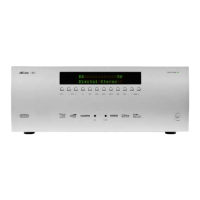10
The 5V relay RY594 is normally open. When the mains switch is closed then the SUB_POWER rail (approx
+4.3V) is activated from the Power Supply PCB via the standby transformer. When the system has
booted correctly, without any shutdown signals, then the POWER_RELAY signal from the system μP
also goes high, pulling down Q5947 hard. Only then does the relay close and switch on the main frame
power transformer, enabling the rest of the system to boot up.
Now consider the Power Supply Board, found on page 14 of the schematic. This generates all the main
DC supplies for the AVR360 except +Vcc and -Vee for the power ampliers and the non-logic part of the
VFD display requirements of the Front Panel Board. Note that additional local regulation also takes place
on the other PCBs, e.g. for large digital ICs.
Two secondary windings from the frame power transformer are fed in via CN63. Pins 1, 2 and 3 con-
nect to a centre-tapped secondary winding used to generate approx +/- 20VDC via the bridge rectier
diodes D603/3/4/5 and the 2,200μF 35V reservoir capacitors C609 and C610. R603 and R604 are 0.47R 1W
fusible resistors for circuit protection – if they fail replace only with the same type and value.
The 3 terminal regulators IC63 and IC62 are mounted on two of the larger heatsinks near the back of the
amplier. These provide +/-15V to the op amps on the amplier’s Input Board via the 11-way connector
BN62. The Input Board also then routes the +/-15V onwards to the Front Panel Board.
Pins 4 and 5 of CN63 receive AC from another transformer secondary to generate approx +15VDC via the
heatsink mounted bridge rectier D601 and the 18,000μF 25V reservoir capacitor C631. F601 and F602
are hard wired 6.3Amp T (time delay) fuses for circuit protection – if they fail replace only with the same type
and value.
This +15V unregulated supply has 4 main outputs:-
1) It is regulated down to +12V with the low dropout (LDO) 3 terminal regulator IC64. This is situ-
ated on the heatsink closest to the Main Board, near the back panel. Its output goes to BN62 for
the +12V triggers and also to CN501, to drive the power ampliers’ cooling fans.
2) It supplies the HDMI Board via CN61. To minimize ripple currents in the ground return, Q643 is
wired as a low dropout voltage follower with low pass ltering via R650 and C569.
3) It feeds the switched mode buck regulator IC61 via L631 and C615. The tank circuit comprises
L632, C640 and C641, discharged via D631. R636 and C643 make up a snubber to reduce over-
shoot. This provides a high current +5V supply to the Input Board via pins 4 and 5 of BN62. This
5V supply also feeds two 3V3 linear regulators, IC67 and IC68. These in turn supply the audio DSP
ICs on the Input Board via pins 10 and 11 of BN62.
4) It feeds the +5V 3 terminal LDO regulator IC66 via the diode D616, which itself is preceded by the
smoothing network comprising R615 (2W 15R) and C615. Note IC66’s output is actually approx
+5.7V because of D644 in its ground line; this is brought back to +5V after D643, to feed the relay
IC66 is noteworthy because it continues working when the amplier is in standby.
It takes a second input from the +9V standby power supply on the Power Amplier PCB – D616 acts as a
gate to prevent this from feeding back to the +15V supply when the system is in standby. It also allows
the +15V supply to override and remove the load from the +9V supply when the amplier is fully booted
up.
D606 and D607 form half of a second bridge rectier (with the other two diodes coming from the full
bridge rectier D601). These diodes charge up the 1μF/50V capacitor C604 to +15V, generating a “mains
power present” signal. The 10K resistor R614 in parallel with C604 continually discharges it so that this

